2008 MERCEDES-BENZ A-CLASS HATCHBACK seats
[x] Cancel search: seatsPage 55 of 305
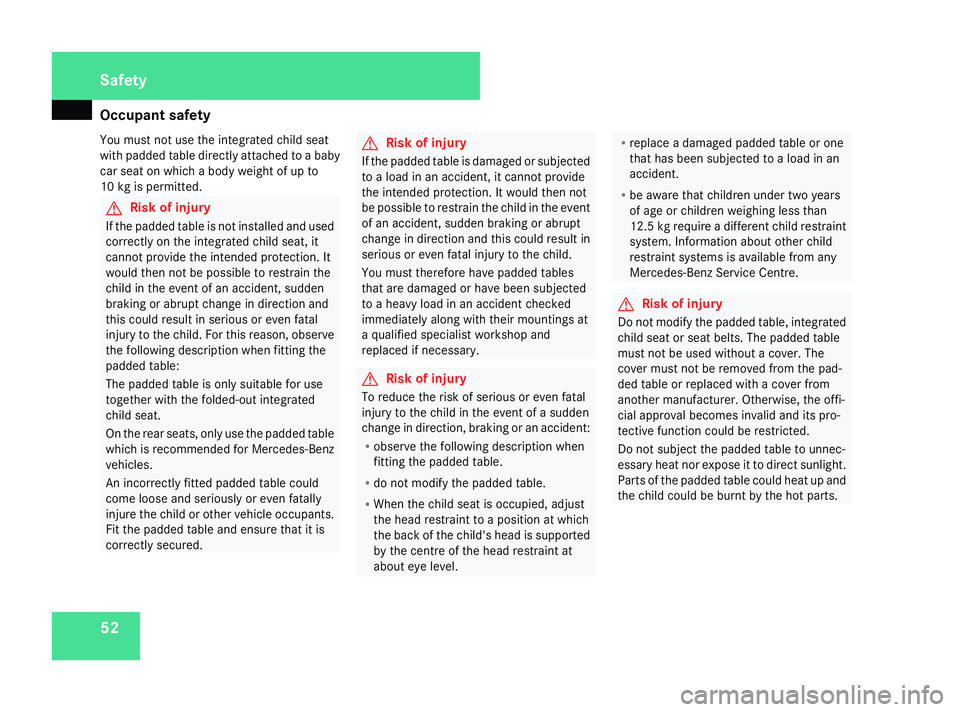
Occupant safety
52
You must not use the integrated child seat
with padded table directly attached to a baby
car seat on which a body weight of up to
10 kg is permitted. G
Risk of injury
If the padded table is not installed and used
correctly on the integrated child seat, it
cannot provide the intended protection. It
would then not be possible to restrain the
child in the event of an accident, sudden
braking or abrupt change in direction and
this could result in serious or even fatal
injury to the child. For this reason, observe
the following description when fitting the
padded table:
The padded table is only suitable for use
together with the folded-out integrated
child seat.
On the rear seats, only use the padded table
which is recommended for Mercedes-Benz
vehicles.
An incorrectly fitted padded table could
come loose and seriously or even fatally
injure the child or other vehicle occupants.
Fit the padded table and ensure that it is
correctly secured. G
Risk of injury
If the padded table is damaged or subjected
to a load in an accident, it cannot provide
the intended protection. It would then not
be possible to restrain the child in the event
of an accident, sudden braking or abrupt
change in direction and this could result in
serious or even fatal injury to the child.
You must therefore have padded tables
that are damaged or have been subjected
to a heavy load in an accident checked
immediately along with their mountings at
a qualified specialist workshop and
replaced if necessary. G
Risk of injury
To reduce the risk of serious or even fatal
injury to the child in the event of a sudden
change in direction, braking or an accident:
R observe the following description when
fitting the padded table.
R do not modify the padded table.
R When the child seat is occupied, adjust
the head restraint to a position at which
the back of the child's head is supported
by the centre of the head restraint at
about eye level. R
replace a damaged padded table or one
that has been subjected to a load in an
accident.
R be aware that children under two years
of age or children weighing less than
12.5 kg require a different child restraint
system. Information about other child
restraint systems is available from any
Mercedes-Benz Service Centre. G
Risk of injury
Do not modify the padded table, integrated
child seat or seat belts. The padded table
must not be used without a cover. The
cover must not be removed from the pad-
ded table or replaced with a cover from
another manufacturer. Otherwise, the offi-
cial approval becomes invalid and its pro-
tective function could be restricted.
Do not subject the padded table to unnec-
essary heat nor expose it to direct sunlight.
Parts of the padded table could heat up and
the child could be burnt by the hot parts. Safety
169_AKB; 2; 4, en-GB
wdomann
,V ersion: 2.10.6
2008-07-16T08:52:06+02:00 - Seite 52 Dateiname: 6515_0315_02_buchblock.pdf; preflight
Page 62 of 305

59
Opening and closing
...........................60
Key positions ....................................... 62
Seats .................................................... 63
Steering wheel .................................... 70
Mirrors ................................................. 70
Seat belts ............................................. 73
Lights ................................................... 77
Windscreen wipers .............................83
Side windows ...................................... 84Driving and parking
............................87
Transmission ....................................... 92
Instrument cluster ..............................97
On-board computer .............................98
Driving systems ................................ 115
Air conditioning ................................. 129
Roof .................................................... 142
Loading and stowing ........................144
Features ............................................. 162 Controls
169_AKB; 2; 4, en-GB
wdomann,
Version: 2.10.6 2008-07-16T08:52:06+02:00 - Seite 59Dateiname: 6515_0315_02_buchblock.pdf; preflight
Page 66 of 305

Seats
63Seats
Points to remember
You can find information about enlarging the
luggage compartment (folding forwards/
removing the rear seats) on (Y page 150).
Depending on the vehicle's equipment, the
seats can be adjusted either manually or elec-
trically. G
Risk of injury
The seats can be adjusted when the key is
removed and the door is open. For this rea-
son, children should never be left unsuper-
vised in the vehicle. They could become
trapped when adjusting a seat. G
Risk of accident
Only adjust the driver's seat when the vehi-
cle is stationary. You will otherwise be dis-
tracted from the road and traffic conditions
and you could lose control of the vehicle as
a result of the seat moving. This could
cause an accident. G
Risk of injury
Make sure that nobody can become trap-
ped when you adjust the seat. Observe the notes concerning the airbag
system.
Secure children as recommended; see
"Children in the vehicle" section.
! When you move the seats, make sure that
there are no objects in the footwell or
behind the seats. Otherwise, you could
damage the seats and the objects.
i The front seats are fitted with active head
restraints (Y page 42). For this reason, it is
not possible to remove the head restraints
from the front seats.
The rear-compartment head restraints can
be removed (Y page 66).
Please contact a Mercedes-Benz Service
Centre for more information. Adjusting the seat manually
1
Seat fore-and-aft adjustment
2 Seat cushion angle*
3 Seat height
4 Backrest angle
Seat fore-and-aft adjustment X
Lift handle 1and slide the seat forwards
or backwards.
X Release handle 1again.
Make sure that you hear the seat engage
into position. Controls
* optional
169_AKB; 2; 4, en-GB
wdomann,
Version: 2.10.6 2008-07-16T08:52:06+02:00 - Seite 63 ZDateiname: 6515_0315_02_buchblock.pdf; preflight
Page 67 of 305
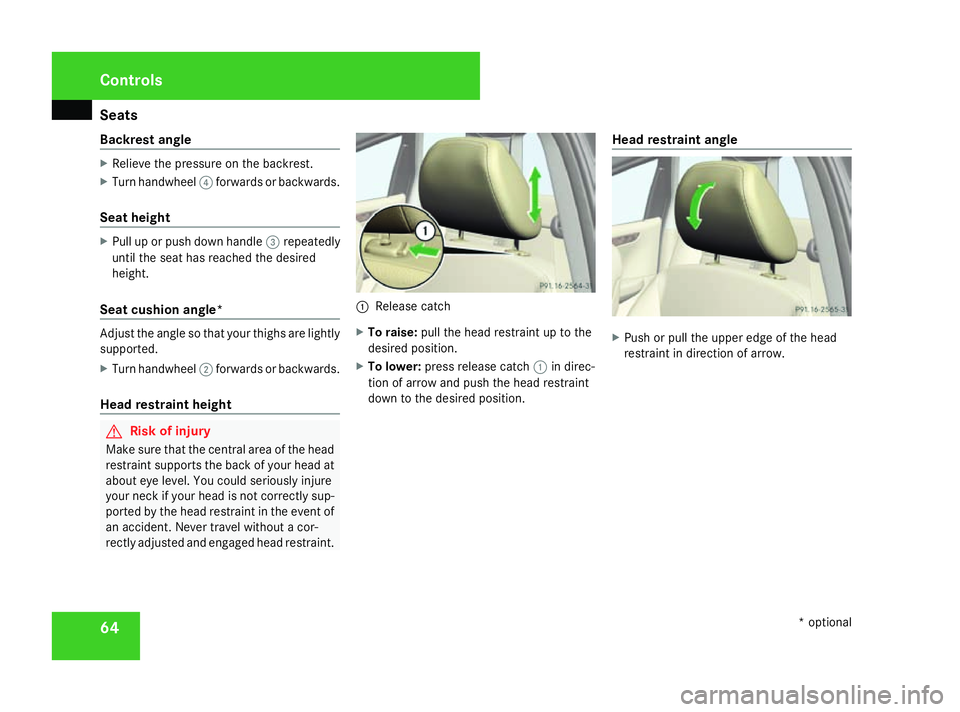
Seats
64
Backrest angle X
Relieve the pressure on the backrest.
X Turn handwheel 4forwards or backwards.
Seat height X
Pull up or push down handle 3repeatedly
until the seat has reached the desired
height.
Seat cushion angle* Adjust the angle so that your thighs are lightly
supported.
X Turn handwheel 2forwards or backwards.
Head restraint height G
Risk of injury
Make sure that the central area of the head
restraint supports the back of your head at
about eye level. You could seriously injure
your neck if your head is not correctly sup-
ported by the head restraint in the event of
an accident. Never travel without a cor-
rectly adjusted and engaged head restraint. 1
Release catch
X To raise: pull the head restraint up to the
desired position.
X To lower: press release catch 1in direc-
tion of arrow and push the head restraint
down to the desired position. Head restraint angle X
Push or pull the upper edge of the head
restraint in direction of arrow. Controls
* optional
169_AKB; 2; 4, en-GB
wdomann,
Version: 2.10.6
2008-07-16T08:52:06+02:00 - Seite 64 Dateiname: 6515_0315_02_buchblock.pdf; preflight
Page 68 of 305

Seats
65Adjusting the seat electrically*
1
Head restraint height
2 Backrest angle
3 Seat fore-and-aft adjustment
4 Seat cushion angle
5 Seat height
X Make sure that the key is in position 1or
2 in the ignition lock or that the respective
door is open.
Seat fore-and-aft adjustment X
Slide the button forwards or back in the
direction of arrow 3. Seat height X
Slide the button up or down in the direction
of arrow 5.
Seat cushion angle Adjust the angle so that your thighs are gently
supported.
X
Slide the button up or down in the direction
of arrow 4.
Backrest angle X
Slide the button forwards or back in the
direction of arrow 2.
Head restraint height G
Risk of injury
Make sure that the central area of the head
restraint supports the back of your head at
about eye level. You could seriously injure
your neck if your head is not correctly sup-
ported by the head restraint in the event of
an accident. Never travel without a cor-
rectly adjusted and engaged head restraint. X
Slide the button up or down in the direction
of arrow 1.
Head restraint angle X
Push or pull the upper edge of the head
restraint in the direction of the arrow. Controls
* optional
169_AKB; 2; 4, en-GB
wdomann,
Version: 2.10.6 2008-07-16T08:52:06+02:00 - Seite 65 ZDateiname: 6515_0315_02_buchblock.pdf; preflight
Page 69 of 305
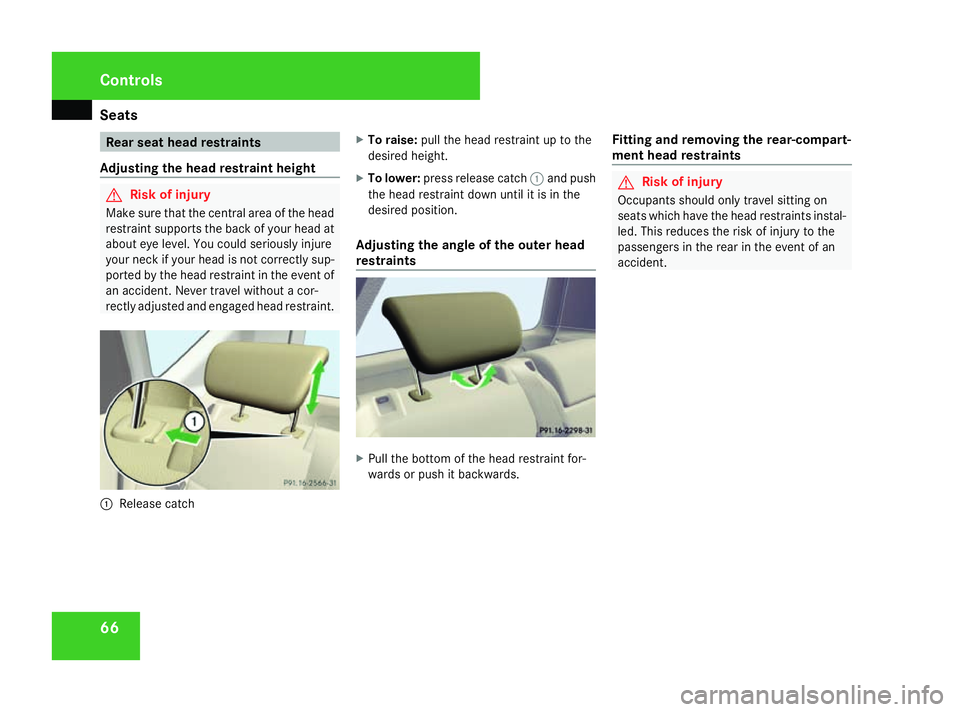
Seats
66 Rear seat head restraints
Adjusting the head restraint height G
Risk of injury
Make sure that the central area of the head
restraint supports the back of your head at
about eye level. You could seriously injure
your neck if your head is not correctly sup-
ported by the head restraint in the event of
an accident. Never travel without a cor-
rectly adjusted and engaged head restraint. 1
Release catch X
To raise: pull the head restraint up to the
desired height.
X To lower: press release catch 1and push
the head restraint down until it is in the
desired position.
Adjusting the angle of the outer head
restraints X
Pull the bottom of the head restraint for-
wards or push it backwards. Fitting and removing the rear-compart-
ment head restraints G
Risk of injury
Occupants should only travel sitting on
seats which have the head restraints instal-
led. This reduces the risk of injury to the
passengers in the rear in the event of an
accident. Controls
169_AKB; 2; 4, en-GB
wdomann,
Version: 2.10.6
2008-07-16T08:52:06+02:00 - Seite 66 Dateiname: 6515_0315_02_buchblock.pdf; preflight
Page 70 of 305
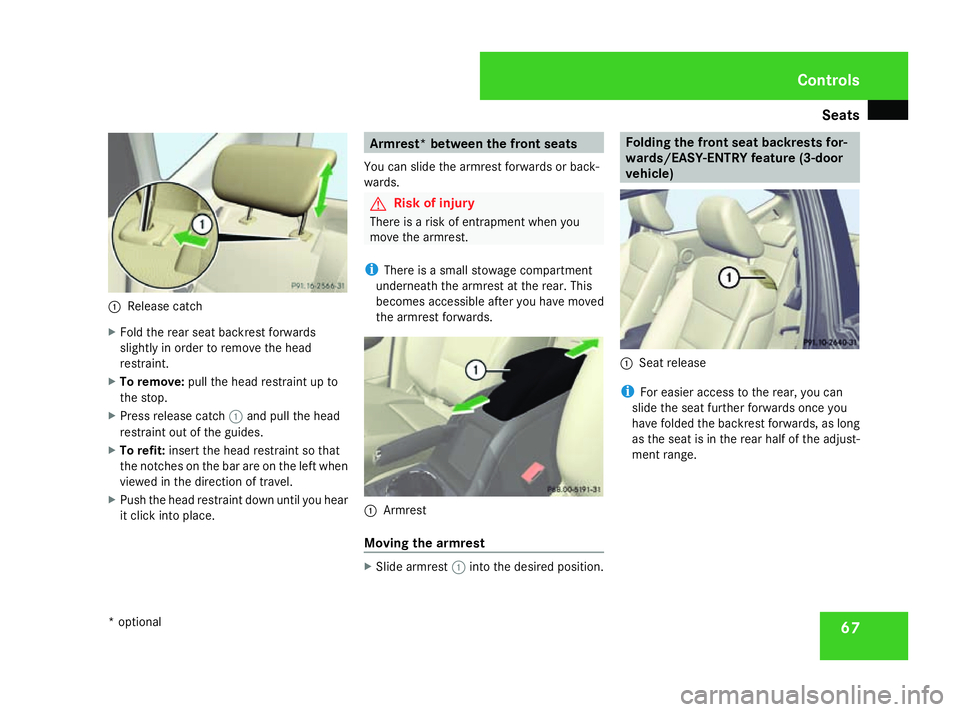
Seats
671
Release catch
X Fold the rear seat backrest forwards
slightly in order to remove the head
restraint.
X To remove: pull the head restraint up to
the stop.
X Press release catch 1and pull the head
restraint out of the guides.
X To refit: insert the head restraint so that
the notches on the bar are on the left when
viewed in the direction of travel.
X Push the head restraint down until you hear
it click into place. Armrest* between the front seats
You can slide the armrest forwards or back-
wards. G
Risk of injury
There is a risk of entrapment when you
move the armrest.
i There is a small stowage compartment
underneath the armrest at the rear. This
becomes accessible after you have moved
the armrest forwards. 1
Armrest
Moving the armrest X
Slide armrest 1into the desired position. Folding the front seat backrests for-
wards/EASY-ENTRY feature (3-door
vehicle) 1
Seat release
i For easier access to the rear, you can
slide the seat further forwards once you
have folded the backrest forwards, as long
as the seat is in the rear half of the adjust-
ment range. Controls
* optional
169_AKB; 2; 4, en-GB
wdomann,
Version: 2.10.6 2008-07-16T08:52:06+02:00 - Seite 67 ZDateiname: 6515_0315_02_buchblock.pdf; preflight
Page 71 of 305
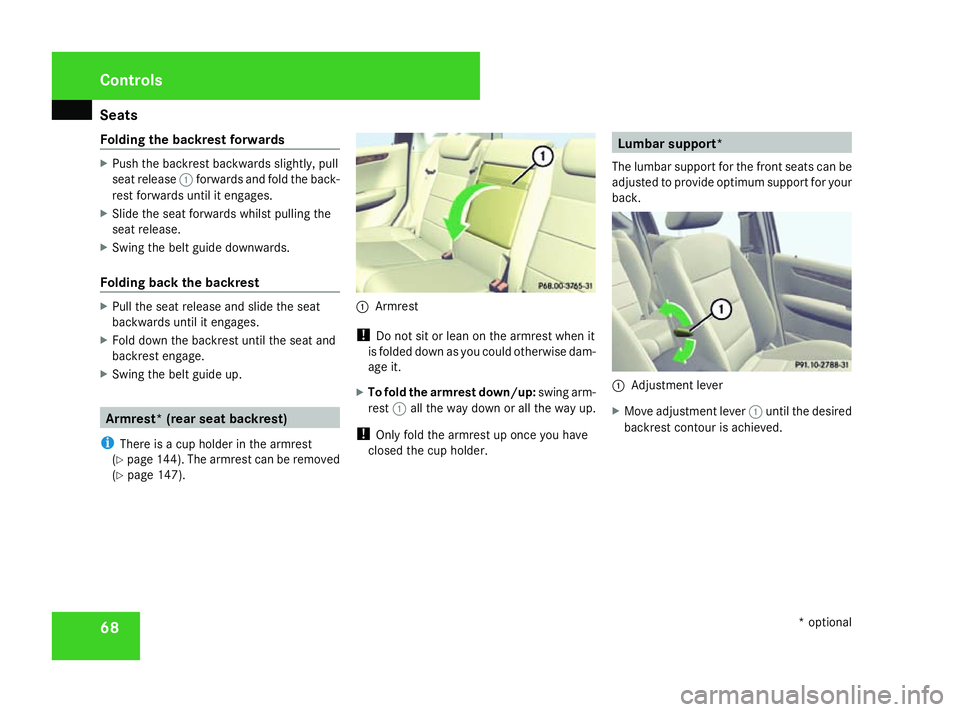
Seats
68
Folding the backrest forwards X
Push the backrest backwards slightly, pull
seat release 1forwards and fold the back-
rest forwards until it engages.
X Slide the seat forwards whilst pulling the
seat release.
X Swing the belt guide downwards.
Folding back the backrest X
Pull the seat release and slide the seat
backwards until it engages.
X Fold down the backrest until the seat and
backrest engage.
X Swing the belt guide up. Armrest* (rear seat backrest)
i There is a cup holder in the armrest
(Y page 144). The armrest can be removed
(Y page 147). 1
Armrest
! Do not sit or lean on the armrest when it
is folded down as you could otherwise dam-
age it.
X To fold the armrest down/up: swing arm-
rest 1all the way down or all the way up.
! Only fold the armrest up once you have
closed the cup holder. Lumbar support*
The lumbar support for the front seats can be
adjusted to provide optimum support for your
back. 1
Adjustment lever
X Move adjustment lever 1until the desired
backrest contour is achieved. Controls
* optional
169_AKB; 2; 4, en-GB
wdomann,
Version: 2.10.6
2008-07-16T08:52:06+02:00 - Seite 68 Dateiname: 6515_0315_02_buchblock.pdf; preflight